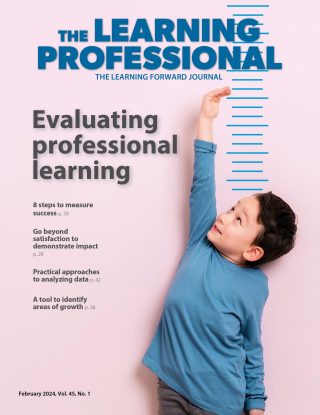FOCUS
Leading The Way In Literacy
Classroom visits offer a comprehensive view of teaching and learning
By Bonnie Houck and Sandi Novak
Categories: Data, Learning designsOctober 2017
Vol. 38 No 5
Schools and districts are required to have improvement plans that specify instructional and curricular ideas to enhance teachers’ ongoing practice and assist students in performing at higher levels. Yet little has been done to examine the specific knowledge that principals need regarding literacy teaching and learning or how districts can build literacy leadership capacity.
Leaders need a system to collect and analyze timely and useful information about current instructional practices in their schools and how students engage and collaborate in the process of learning. These data must be collected consistently for instructional growth and without the intent of using them to evaluate individual teaching performance.
A Better Way
Many districts need clear classroom data focused on the literacy culture and instructional practices being implemented in each school. Understanding these elements is crucial for success, and this is where the Literacy Classroom Visit Model can make a difference.
Collecting and using Literacy Classroom Visit Model data from every school across a district can provide a richer, more comprehensive view of the status of teaching and learning districtwide. Districts can use these data to design improvement plans and help outline the best strategies for reaching district and school goals.
Literacy classroom visits are brief, frequent, informal, and focused visits to classrooms by observers whose purpose is to gather data about teaching practices and engage in collaborative follow-up (Houck & Novak, 2016). Like instructional rounds and three-minute walk-throughs, literacy classroom visits can be conducted in teams and focus on student learning and collaborative discussion around descriptive, nonjudgmental data. However, they are unique in that they concentrate specifically on research-supported practices that have a direct effect on literacy achievement.
The Literacy Classroom Visit Model is also distinctive in terms of how data are collected and analyzed to direct the focus on specific data patterns. These patterns highlight instruction and learning of the community rather than the practices of individuals. Over time, they reveal evidence of a developing culture of literacy as well as effective practices.
District Leaders’ Role
Districts are the logical avenue to provide the support school leaders need to improve literacy teaching and learning. Ensuring that schools get what they need without causing undue frustration requires a balanced partnership and clarity between districts and schools. District administrators who create a learning environment based on trust and clearly established norms for collaboration create a culture in which the Literacy Classroom Visit Model can bear fruit.
District leadership, according to Learning Forward’s (2011) Standards for Professional Learning, should provide professional learning experiences that enable principals to function as instructional leaders.
With the Literacy Classroom Visit Model, district leaders and principals have distinct, mutually reinforcing roles. The central office assumes responsibility for defining goals and standards for teaching and learning, allocating resources to schools, and providing the supports that principals and teachers need to successfully meet district-established literacy standards.
Principals and teachers are responsible for implementing teaching and learning goals, using school-based professional development resources, and developing strategies for evaluating their progress. District leaders can assist with schools’ collection, analysis, and use of literacy classroom visit data for decision making. Specifically, districts can help schools improve the validity, reliability, and relevance of the data collected and provide technical assistance or training in using the data to inform management, instruction, and literacy improvement.
Finally, district leaders can give principals opportunities to share and learn about strategies and approaches that support quality teaching. By providing this time, district leaders foster intentional collaboration among leaders as they work toward integrating the Literacy Classroom Visit Model into ongoing, consistent practices across the district.
Principal Learning
The best way to grow a district’s capacity to improve teaching and learning is to ensure that every school becomes a model of effective professional learning through collaboration and collegiality. To increase their effectiveness in raising student achievement, principals also need opportunities to participate in learning opportunities with their peers (Mizell, 2009).
Districts can build leaders’ capacity to work together effectively by developing a cadre of principals and other leaders who work with learning teams within their schools. For principals to understand, value, and lead these learning teams, they need to experience working within facilitated study teams themselves.
A strategy to provide professional learning for a large group of principals using economies of scale is to offer it through the state principals organization. To make the greatest impact, state organizations should ensure the professional learning is focused, job-embedded, and sustained. Offering leadership teams professional learning for the Literacy Classroom Visit Model through the state principals organization provides consistency and creates a statewide support network for leaders as they develop processes for instructional growth and change.
In Minnesota, groups of principals meet for the first two days of a four-day professional learning experience during the summer to learn about and be able to identify quality literacy instruction in classrooms. After building foundational knowledge, they go back to their schools to gather data that indicate the status of literacy teaching and student learning. Principals observe all classrooms at least two times during a four- to six-week period gathering data before returning for their third day of professional learning.
On day three, leaders work together to analyze their school data patterns, discussing and learning from each other’s data while thinking collaboratively about possible next steps. They also learn how to include reflective practices in the professional learning culture within the school. At the end of the day, principals are equipped with different, enhanced instruments. They return to their schools to visit classrooms and collect data with a tighter focus.
A month later, during day four, leaders learn to use the data to develop action steps to address the common patterns that emerge from the literacy data. They discuss how to share their data analysis and recommendations for resources and professional learning with teachers by using critical, nonevaluative language seated in data.
Prepared with extended knowledge of what effective literacy instruction looks like and how to monitor if professional development is implemented with fidelity, these principals are ready to lead their literacy improvement efforts with confidence.
Katy Schuerman, a principal in Wanamingo, Minnesota, says that, since engaging in professional learning about the literacy classroom visit, “I have a clear vision of what instructional practices can make a difference.”
Jim Schimelpfenig, a principal in Howard Lake, Minnesota, says that literacy classroom visits “will impact not only literacy instruction but all instruction in my school.”
Mounds View Public Schools
Several school districts sent all of their principals and associate principals or district leaders to the Minnesota Elementary School Principals’ Association Literacy Academy to learn to use the Literacy Classroom Visit Model throughout their schools.
Professional learning for principals in the Mounds View Public Schools began with the principals participating in four days of learning about the Literacy Classroom Visit Model, where they examined important areas specific to the culture and context they lead.
When principals returned to their schools to gather two rounds of data, the 10 Mounds View principals wanted to conduct one round of data in a school together. Conducting literacy classroom visits with literacy leaders is, in itself, useful professional learning for principals.
Their discussions about the attributes identified on the literacy classroom visit instrument help them identify what is being taught, and the process of identifying and communicating areas of strength and need deepens their content knowledge and enhances their ability to hold meaningful and focused conversations with teachers about their instruction and student learning.
Building a community of leaders is vital to improving instructional leadership. As leaders work together to learn and discuss developing practices, they create relationships that have a positive effect on those whom they lead (Spillane, 2006). As teachers see their leaders working and growing together, they respond to the model of collaboration.
Allison Storti, a principal in Mounds View, Minnesota, says, “There is so much power in being aligned across the whole district. It’s important for the staff and community to see that we are all having common conversations using the Literacy Classroom Visit Model.”
Storti’s colleague, Todd Durand, who is also a principal in Mounds View, added, “We have more kids reading than ever before. They love to read. Since we have dedicated our professional learning to literacy, we have more books checked out from the school library, the guided reading library, and classroom libraries. Students know what they are supposed to learn and do, using their own work as evidence of accomplishment. This revitalization and focus on literacy-based professional learning has changed our instructional practice.”
A Districtwide Culture of Literacy
Districts play important roles in promoting and sustaining the successful use of the Literacy Classroom Visit Model. When district leaders assume responsibility for building capacity through their school leaders, they develop a collaborative culture that supports application of the model and builds a flourishing literacy environment.
If the model is part of a multischool initiative, district leaders can help ensure that all school leaders conduct useful and powerful literacy classroom visits by providing professional learning for principals and teacher leaders from each school, conducting literacy classroom visits in small groups and analyzing the data together, offering coaching, and providing additional access to outside experts when needed.
Leaders in New Prague Area Schools in Minnesota value professional learning for their teachers and realized that the district was ready for an intentional plan for consistent instruction to enhance literacy achievement for all students. We worked with the district to provide guidance in using the Literacy Classroom Visit Model to identify specific areas of strength and need. Our first step was to work with the director of curriculum and instruction to determine the district’s needs before working with the leadership team.
The process for principals and district leaders began with a full day dedicated to learning about current research-based practices in literacy and how to use the model. Next, principals led a staff meeting in their schools to explain the process and how data would be collected and used. A teacher survey gauged their knowledge of current literacy practices.
As a team, leaders conducted literacy classroom visits in each school to determine baseline patterns of strength and need. Within a few weeks, they collected a second series of data, then reflected on and discussed what they gathered.
The emerging patterns from the literacy classroom visits and teacher surveys affirmed that literacy was highly valued across the district and teachers supported students’ literacy development by offering classroom libraries and a variety of literacy learning opportunities across grade levels.
Teachers posted learning targets and provided time for students to read independently. Data also revealed that, while the district demonstrated a literacy culture and elements of solid instruction, it lacked consistency in every classroom and across the district. Conversation among the leaders focused on how to move from good instruction to great.
Patterns indicated several important areas in need of growth: organizing classroom libraries to support student self-selection of texts for independent reading and application; establishing a practice of conferring with students about their reading on a regular basis; writing, teaching, and assessing learning targets; and using effective small-group instruction to support the shift in ownership from teacher to student.
While many classrooms posted learning targets, the targets did not provide clear performance criteria so that students could know what they were expected to learn, do, and show to move toward proficiency. And, although teachers taught and modeled learning goals in whole-group lessons, this support didn’t extend to small-group guided practice and independent reading and application. Teachers dedicated some time to independent reading, but students needed support in self-selecting texts across their reading range to apply their learning while reading.
Equipped with the teacher survey and classroom visits data, leaders developed a three-year plan for resource allocation and professional learning that included periodic classroom visits to ensure learning is applied and integrated into classroom instruction. These visits also help assess the impact of instructional changes on student growth and achievement.
Maren Bahler, director of curriculum and instruction in New Prague, Minnesota, said, “As we implement the Literacy Classroom Visit Model systematically in all elementary buildings, our district leaders are more aware of what to look for, in a particularly efficient way, to ensure best practice of literacy instruction.”
A Catalyst for Lasting Change
Strong leaders recognize the value of effective teachers and the instructional environments they create. Accordingly, they understand how important it is to identify and provide the resources and professional learning experiences that teachers need to increase student achievement (DuFour & Mattos, 2013).
The Literacy Classroom Visit Model supports leaders in this task by helping them collect and analyze information about current classroom practices and provides teachers with the support they need to grow. Used well, the model is a catalyst for lasting change. By incorporating purposeful literacy classroom visits into their improvement efforts, principals can create and sustain a powerful culture of literacy throughout the school community.
Tom Cawcutt, a principal in Barnum, Minnesota, describes the impact of the Literacy Classroom Visit Model: “Using the Literacy Classroom Visit Model to guide our professional learning has changed the way we teach and students learn. Our teachers have transformed literacy instruction by providing lessons aligned to standards with a specific focus on learning targets, using data to improve instruction, and meeting student needs in a targeted manner.
“Our students are stronger readers as a result of common, schoolwide reading practices, and instruction that meets their individual needs. Given the gradual release model of instruction, students now take further ownership of their reading, which has empowered them as learners. Our assessment data have shown an increase of over 20% over the past four years. The Literacy Classroom Visit Model works.”
Bonnie Houck (houckreadz@gmail.com) is an education consultant, author, and professor. Sandi Novak (snovak9133@gmail.com) is an education consultant and author.
References
DuFour, R. & Mattos, M. (2013). How do principals really improve schools? Educational Leadership, 70(7), 34-40.
Houck, B. & Novak, S. (2016). Literacy unleashed: Fostering excellent reading instruction through classroom visits. Alexandria, VA: ASCD.
Learning Forward. (2011). Standards for Professional Learning. Oxford, OH: Author.
Mizell, H. (2009, February). Top performance requires that system leaders develop principals’ learning. The Learning System, 4(5), 2.
Spillane, J.P. (2006). Distributed leadership. San Francisco, CA: Jossey‐Bass.
Categories: Data, Learning designs
Recent Issues
TAKING THE NEXT STEP
December 2023
Professional learning can open up new roles and challenges and help...
REACHING ALL LEARNERS
October 2023
Both special education and general education teachers need support to help...
THE TIME DILEMMA
August 2023
Prioritizing professional learning time is an investment in educators and...
ACCELERATING LEARNING
June 2023
Acceleration aims to ensure all students overcome learning gaps to do...












